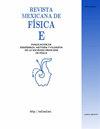Schrödinger和普朗克振子:对于一个修正的爱因斯坦固体来说,物理学并不完全相同
Q4 Social Sciences
引用次数: 0
摘要
在量子谐振子的统计力学中,零点能量可以包含(薛定谔振子),也可以省略(普朗克振子)。对于通常的结果来说,振子的类型没有区别,但是,更仔细地观察,结果是包含或不包含这种能量并非没有后果。介绍了一个简单的模型,我们称之为修正爱因斯坦固体(MES)。在该模型中,振子的频率随固体体积的变化而变化,这种变化的特征是Gruneisen参数的一定值。比热与标准爱因斯坦模型相同,但在MES中可以计算压力、状态方程和体积模量。使用普朗克振子,压力在体积方面表现出异常行为,并且体积模量在某些温度和体积值下变为负值,这在物理上是不正确的。当使用薛定谔振子时,体积模量总是正的。因此,两种振子的不同行为表明,只有薛定谔振子才能得到正确的结果。本文章由计算机程序翻译,如有差异,请以英文原文为准。
Schrödinger and Planck oscillators: not quite the same physics for a modified Einstein solid
In the statistical mechanics of quantum harmonic oscillators, the zero-point energy can either be included (Schrodinger oscillators) or omitted (Planck oscillators). For the usual results, the type of oscillator makes no difference but, looking more closely, it turns out that including or not this energy is not without consequences. A simple model is introduced that we called the modified Einstein solid (MES). In this model the frequency of the oscillators change with the volume of the solid, and this change is characterized by a certain value of the Gruneisen parameter. The specific heat is the same as in the standard Einstein model, but the pressure, equation of state and bulk modulus can be evaluated in the MES. Using Planck oscillators, the pressure shows an anomalous behavior in terms of the volume, and the bulk modulus becomes negative for certain temperature and volume values, which is physically incorrect. When Schrodinger oscillators are used, the bulk modulus is always positive. Therefore, the different behavior of both types of oscillators indicates that only Schrodinger oscillators lead to correct results.
求助全文
通过发布文献求助,成功后即可免费获取论文全文。
去求助
来源期刊

Revista Mexicana De Fisica E
社会科学-科学史与科学哲学
CiteScore
0.80
自引率
0.00%
发文量
14
审稿时长
>12 weeks
期刊介绍:
The Revista Mexicana de Física (Rev. Mex. Fis.) publishes original papers of interest to our readers from the physical science com unity. Language may be English or Spanish, however, given the nature of our readers, English is recommended. Articles are classified as follows:
Research. Articles reporting original results in physical science.
Instrumentation. Articles reporting original contributions on design and construction of scientific instruments. They should present new instruments and techniques oriented to physical science problems solutions. They must also report measurements performed with the described instrument.
Reviews. Critical surveys of specific physical science topics in which recent published information is analyzed and discussed. They should be accessible to physics graduate students and non specialists, and provide valuable bibliography to the specialist.
Comments. Short papers (four pages maximum) that assess critically papers by others authors previously published in the Revista Mexicana de Física. A comment should state clearly to which paper it refers.
 求助内容:
求助内容: 应助结果提醒方式:
应助结果提醒方式:


